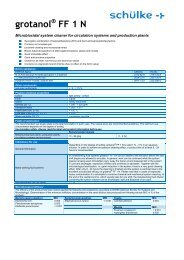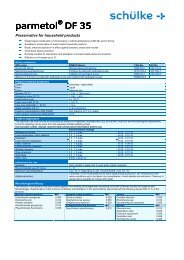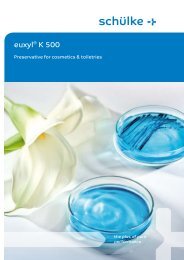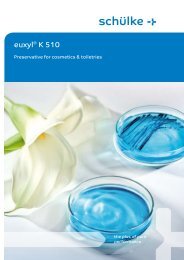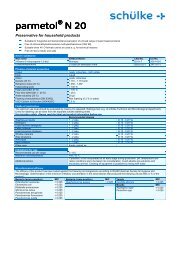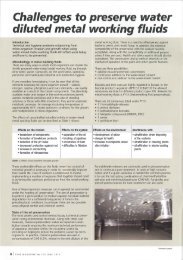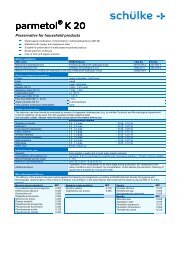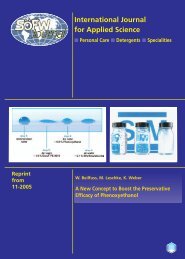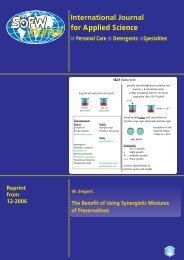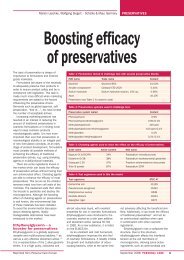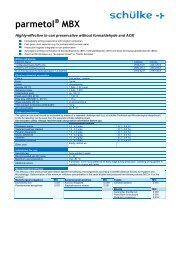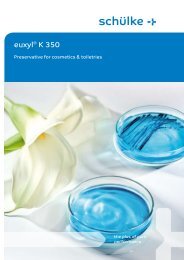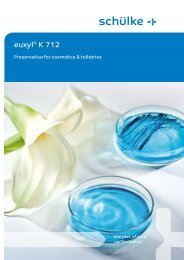A Reliable Alternative for Traditional Preservative ... - Schülke & Mayr
A Reliable Alternative for Traditional Preservative ... - Schülke & Mayr
A Reliable Alternative for Traditional Preservative ... - Schülke & Mayr
You also want an ePaper? Increase the reach of your titles
YUMPU automatically turns print PDFs into web optimized ePapers that Google loves.
International Journal<br />
<strong>for</strong> Applied Science<br />
Personal Care Detergents Specialties<br />
Reprint<br />
from 4-2006<br />
M. Leschke, S. Wüstermann<br />
A <strong>Reliable</strong> <strong>Alternative</strong><br />
<strong>for</strong> <strong>Traditional</strong> <strong>Preservative</strong> Systems
COSMETICS<br />
PRESERVATION<br />
M. Leschke, S. Wüstermann*<br />
A <strong>Reliable</strong> <strong>Alternative</strong> <strong>for</strong> <strong>Traditional</strong><br />
<strong>Preservative</strong> Systems<br />
Keywords: cosmetic preservation, enhanced phenoxyethanol, traditional paraben mixtures<br />
Abstract<br />
Cosmetic preservation is increasingly<br />
under pressure. Industry<br />
sensitivity towards the<br />
toxicology of biocides has been<br />
raised. Europe and the U.S. have<br />
started re-evaluating the safety of<br />
cosmetic preservatives. As more<br />
cosmetic manufacturers want to<br />
go »global«, the public debate<br />
around the world regarding traditional<br />
cosmetic preservatives limits<br />
the options available to cosmetic<br />
manufacturers. Cosmetic<br />
<strong>for</strong>mulators are realising the need<br />
<strong>for</strong> alternative approaches to<br />
product protection. To meet these<br />
market requirements Euxyl ® PE<br />
9010, a new concept in preserving<br />
cosmetics, has been introduced. In<br />
the following article, the antimicrobial<br />
efficacy of Euxyl ® PE 9010<br />
is compared to a traditional<br />
preservative mixture <strong>for</strong> leave-on<br />
cosmetics.<br />
Introduction<br />
One of the most commonly used preservative<br />
systems <strong>for</strong> cosmetics are standard<br />
blends of phenoxyethanol and parabens.<br />
25g of each material to be tested<br />
without<br />
preservative<br />
Germ spectrum<br />
Bacteria:<br />
grampositive<br />
Micrococcus luteus<br />
Staphylococcus aureus<br />
gramnegative<br />
Enterobacter gergoviae<br />
Escherichia coli<br />
Klebsiella pneumoniae<br />
Pseudomonas aeruginosa<br />
Pseudomonas fluorescens<br />
Pseudomonas putida<br />
with x %<br />
preservative<br />
Moulds:<br />
Aspergillus niger<br />
Penicillium funiculosum<br />
Yeasts:<br />
Candida albicans<br />
Fig. 1 Evaluation of the microbial stability of cosmetic <strong>for</strong>mulations with the<br />
S&M Koko test<br />
Particularly in leave-on products like<br />
creams and lotions, a blend of methyl-,<br />
propyl-, ethyl-, butyl- and isobutylparaben<br />
in phenoxyethanol is a standard<br />
preservative option (1). Cosmetic chemists<br />
have used this type of system <strong>for</strong> decades<br />
in the development of »global« <strong>for</strong>mulations.<br />
However, as the list of globallyapproved<br />
preservatives is limited, cosmetic<br />
manufacturers are continually interested<br />
in new alternative preservation<br />
S&M Koko test<br />
periodic microbiological preservation test weekly<br />
inoculation with 0.2 ml mixed suspension<br />
6 weeks = 6 inoculation cycles (titre 10 8-9 cfu/ml)<br />
0.2 ml<br />
storage at +25°C<br />
Streak weekly be<strong>for</strong>e each inoculation<br />
on CS- and Sa-Agar<br />
Incubation of the<br />
nutrient media:<br />
3 days at + 25°C<br />
Assessment:<br />
- free of growth<br />
+ slight growth<br />
++ moderate growth<br />
+++ heavy growth<br />
selective identification of<br />
bacteria, yeasts and moulds<br />
systems. Due to this market demand,<br />
preservative suppliers are putting great<br />
ef<strong>for</strong>ts in developing alternatives <strong>for</strong> the<br />
market (2,3). By combining a well-known,<br />
accepted preservative active – phenoxyethanol<br />
– with an innovative, multifunctional<br />
cosmetic additive – ethylhexylglycerin<br />
– the new preservative Euxyl®<br />
PE 9010 is meeting the market requirement<br />
<strong>for</strong> new preservative concepts (4).<br />
This new preservative has been challenge<br />
2 SÖFW-Journal | 132 | 4-2006
COSMETICS<br />
PRESERVATION<br />
tested in more than 350 different cosmetic<br />
products, both alone and in comparison<br />
studies vs. different traditional<br />
cosmetic preservative systems. These tests<br />
have proven Euxyl® PE 9010 to be an interesting<br />
alternative <strong>for</strong> cosmetic preservation.<br />
Products tested 44<br />
Products with the same result 40<br />
Products where the paraben mixture is slightly better 2<br />
Products where Euxyl® PE 9010 is slighty better 2<br />
Table 1 Comparison of the efficacy of Euxyl® PE 9010 vs. phenoxyethanol based<br />
paraben mixtures in leave on<br />
Method<br />
Challenge tests have been per<strong>for</strong>med according<br />
to the S&M Koko test method (5,<br />
6) (Fig. 1).<br />
The S&M Koko test is a repeated challenge<br />
test designed and validated by<br />
Schülke & <strong>Mayr</strong>. A mixed suspension of<br />
Gram-positive and Gram-negative bacteria,<br />
yeast and mould is used <strong>for</strong> six inoculations<br />
at weekly intervals. Parallel to<br />
each inoculation a sample of the tested<br />
product is streaked out onto nutrient<br />
media, incubated and evaluated semiquantitatively.<br />
The longer the time be<strong>for</strong>e<br />
the occurrence of the first microbial<br />
growth, the more effective is the preservative.<br />
Experience has shown that a wellpreserved<br />
product should remain growthfree<br />
<strong>for</strong> six inoculation cycles to ensure<br />
the shelf-life required in practice (30<br />
months in the original packaging).<br />
Results<br />
The results of the testing done shows<br />
that Euxyl® PE 9010 is most suitable<br />
<strong>for</strong> the preservation of leave-on cosmet-<br />
Test material/Product<br />
Inoculation Cycles<br />
0 1 2 3 4 5 6<br />
Hand and nail cream, unpreserved -<br />
+++ +++<br />
B,Y,M B,Y,M<br />
./.<br />
+ 1.0 % paraben mixture * - - - - - - -<br />
+ 1.0 % Euxyl® PE 9010 - - - - - - -<br />
LV Sun spray, unpreserved<br />
++ +++ +++<br />
-<br />
B,Y,M B,Y,M B,Y,M<br />
./.<br />
++ ++ +++ +++<br />
+ 0.5 % paraben mixture *<br />
-<br />
Y Y Y B,Y<br />
./.<br />
+ 1.0 % paraben mixture * - - - - - - -<br />
+ 0.5 % Euxyl® PE 9010<br />
-<br />
++ ++ +++ +++<br />
Y Y Y B,Y<br />
./.<br />
+ 1.0 % Euxyl® PE 9010 - - - - - - -<br />
Fragrance free dry skin Cream, - ++ +++ +++<br />
unpreserved B,Y,M B,Y,M B,Y,M<br />
./.<br />
+ 1.0 % paraben mixture *<br />
+ 1.0 % Euxyl® PE 9010<br />
-<br />
-<br />
+<br />
+<br />
++<br />
+<br />
++<br />
+<br />
+<br />
+<br />
+<br />
+<br />
+<br />
+<br />
B<br />
B<br />
B<br />
B<br />
B<br />
B<br />
B<br />
B<br />
B<br />
B<br />
B<br />
B<br />
O Sterility control - free of microbial growth<br />
B Bacteria + slight growth<br />
M Moulds ++ moderate growth<br />
Y Yeast +++ massive growth<br />
Fig. 2 Comparison of the efficacy of Euxyl® PE 9010 vs. a traditional paraben mixture during six inoculation cycles<br />
(* methyl-, ethyl-, propyl-, butyl- and isobutylparaben in phenoxyethanol)<br />
SÖFW-Journal | 132 | 4-2006 3
COSMETICS<br />
PRESERVATION<br />
ics such as creams, lotions, wet wipes,<br />
hair care and hair styling products. For<br />
these products one of the market-leading<br />
preservative systems is the combination<br />
of methyl-, propyl-, ethyl-, butyland<br />
isobutylparaben in phenoxyethanol.<br />
To study the efficacy of the combination<br />
of phenoxyethanol and the preservative<br />
enhancer ethylhexylglycerin vs. traditional<br />
phenoxyethanol/paraben mixtures, S&M<br />
Koko tests were per<strong>for</strong>med. The results<br />
are impressive. 40 out of the 44 products<br />
tested showed the same challenge test<br />
result whether preserved with Euxyl® PE<br />
9010 or the paraben mixture (Table 1).<br />
Slight differences in the efficacy between<br />
the two systems could be observed in only<br />
4 products.<br />
Based on the main application area <strong>for</strong><br />
paraben mixtures – leave-on products –<br />
90 % of the products tested show nearly<br />
identical results in preservative efficacy<br />
<strong>for</strong> the traditional paraben mixture<br />
and Euxyl® PE 9010. If the paraben blend<br />
passed the test Euxyl® PE 9010 passed also<br />
and vice versa. If the paraben mixture<br />
was not effective in preserving a cosmetic<br />
<strong>for</strong>mulation the enhanced phenoxyethanol<br />
failed as well.<br />
The comparable efficacies of the traditional<br />
paraben mixture and Euxyl® PE<br />
9010 is shown <strong>for</strong> different customer<br />
products (Fig. 2).<br />
Discussion<br />
As all three examples – a hand and nail<br />
cream, a sun spray and a fragrance free<br />
dry skin cream – show, the challenge<br />
tests have the same test characteristics<br />
irrespective of whether the preservative<br />
is a paraben mixture or Euxyl® PE 9010.<br />
While the hand and nail cream and the<br />
sun spray stay well preserved during six<br />
inoculation cycles with 1.0 % of the<br />
paraben mixture as well as 1.0 % Euxyl®<br />
PE 9010, the fragrance free dry skin<br />
cream shows slight growth of bacteria<br />
during the entire challenge test with<br />
both preservatives.<br />
The test results show that Euxyl® PE 9010<br />
is as effective as a traditional phenoxyethanol/paraben<br />
mixture when<br />
used at equivalent concentrations. It is<br />
recommended to check the stability and<br />
preservative efficacy in individual cosmetic<br />
products as any change in the<br />
preservative system may affect the per<strong>for</strong>mance<br />
of the <strong>for</strong>mulation.<br />
Conclusion<br />
Due to ongoing discussions regarding<br />
preservative actives, <strong>for</strong>mulators are increasingly<br />
looking <strong>for</strong> new options. With<br />
Euxyl® PE 9010 a reliable alternative to<br />
the commonly used phenoxyethanolbased<br />
paraben mixtures was introduced.<br />
As proven in several challenge tests, it is<br />
particularly effective <strong>for</strong> the preservation<br />
of leave-on cosmetics, such as<br />
creams, lotions, wet wipes, hair care and<br />
styling products. This new preservative<br />
system has been proven effective in almost<br />
every product where the standard<br />
paraben mixture is effective and it is an<br />
alternative to classical preservative<br />
blends.<br />
References<br />
(1) D. Steinberg, <strong>Preservative</strong>s <strong>for</strong> Cosmetics, Second<br />
Edition, 31, Allured Publishing Corporation,<br />
Carol Stream, USA (2006), 11 – 14<br />
(2) M.S. Reisch, Chemical & Engeneering News, 2005,<br />
Nov. 14, 25 – 27<br />
(3) D. de Guzman, Chemical Market Reporter, 2005,<br />
Vol. 268, 19, Dec. 5 – 18, 20 – 22<br />
(4) W. Beilfuss, M. Leschke, K. Weber, SÖFW-Journal<br />
2005,11,30 – 36<br />
(5) K. Weber, J. Siebert, SÖFW-Journal, 2003, 6, 44<br />
– 50 (English); 48 – 55 (German)<br />
(6) W. Siegert, Cosmetic Science Technology, 2005,<br />
189 – 195<br />
* Authors’ address:<br />
Dr. Marion Leschke<br />
Silke Wüstermann<br />
Schülke & <strong>Mayr</strong> GmbH<br />
Special Additive International<br />
22840 Norderstedt<br />
Germany<br />
Mailto: sai@schuelke-mayr.com<br />
<br />
4 SÖFW-Journal | 132 | 4-2006




